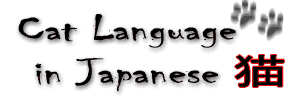
Departments

Cats seem to fascinate every culture. The ancient Egyptians viewed cats as sacred animals, while in the West, cats were often viewed as portents of evil. During the witch hysterias that swept Europe and America, the black cat was reputed to have been the witch's demonic familiar in animal disguise. Westerners also marvel at the cat's ability to maneuver its way out of predicaments, as indicated by the English observation that all cats seem to have nine lives. The Spanish use the cat as a metaphor for subterfuge and suspicion. The Spanish proverb, "Aquí hay gato encerrado", means, "There's a cat hidden here", or "There's something fishy here."
The Japanese have a wide array of metaphors and proverbs related to the 猫neko, or cat. One of the most interesting of these is neko-baba 猫糞. Literally translated, neko-baba means "cat droppings". However, the nature of this word's metaphorical usage relates to what cats do after depositing their droppings. Anyone who has spent time around cats knows that cats, unlike dogs, bury their deposits with sand or loose dirt. Neko-baba 猫糞therefore refers to a furtive act of theft, in which the culprit attempts to conceal his actions:
Uchi no keiri-buchoo wa kaisha kara taikin o neko-baba shita.
内の経理部長は会社から大金を猫糞した。
"The manager of our Accounting Department embezzled a large sum of money from the company."
Although the dictionary translation of neko-baba猫糞is most often "embezzlement", neko-baba 猫糞can refer to any sort of sneaky theft in which one attempts to go undetected:
Keiko-san ga nete iru uchi ni, kare wa kanojo no saifu kara 10,000-en o neko-baba shita.
恵子さんが寝ている内に、彼は彼女の財布から一万円を猫糞し
"While Keiko was sleeping, he furtively stole 10,000 yen from her wallet."
Neko-baba 猫糞 would not be used to describe a crime such as armed robbery, in which the culprit's actions are overt, and no attempt is made to conceal the crime.
* * *
Cats have sensitive tongues, and neko-jita 猫舌 is used to describe a person who is sensitive to hot liquids or foods.
Watashi wa neko-jita de, kohii o amari nomanai.
私は猫舌で、コーヒーをあまり飲まない。
"My tongue is sensitive to heat, so I don't drink much coffee."
Neko-jita猫舌is yet another example of a Japanese word that fits a very narrow context. Note that neko-jita 猫舌 does not refer to people who don't like spicy foods.
* * *
People tend to have an air of confidence when they are on their home turf, but many of us become timid in unfamiliar surroundings. The Japanese phrase karite kita neko no yoo 借りてきた猫のよう ("like a borrowed cat") refers to sudden timidity in the face of an unknown or new environment.
Osaka no shiten ni tenkin shita ato, Kasuga-san wa karite kita neko no yoo ni enryo bukaku narimashita.
大阪の支店に転勤した後、春日さんは借りてきた猫のように遠慮深くなりました。
"After being transferred to the Osaka office, Kasuga-san became as reserved as a borrowed cat."
One final point about karite kita neko no yoo借りてきた猫のよう : this phrase describes a change in behavior. In the above example, the implication is that Kasuga-san was not unusually reserved before transferring to Osaka. If he had always been a reserved person, then we wouldn't have needed to use karite kita neko no yoo借りてきた猫のよう in the sentence. We could have said something like,
Osaka no shiten ni tenkin shita ato, Kasuga-san wa itsumo no yoo ni enryo bukakatta desu.
大阪の支店に転勤した後、春日さんはいつものように遠慮深かったです。
"After being transferred to the Osaka office, Kasuga-san was as reserved as always."
* * *
Cats are invoked to describe several common household items. If there are any antique or antique-style tables in your home, you may notice that the legs of these tables is crafted into a curvature. Coincidentally, the hind legs of a cat form a similar shape when the cat is standing on all fours. The Japanese have seized upon this, and refer to this type of table leg as a neko-ashi 猫足. Another item named for the cat is the neko-guruma 猫車, or wheelbarrow.
When I hear or read the word neko-guruma, I have an image of the cartoon cat Garfield, lying complacently on his back with a smile as his hapless owner gives him a wheelbarrow ride. Those of you have owned real cats (at one time during my childhood, I owned nine) can attest to the unlikelihood of a cat sitting still inside a moving wheelbarrow.



